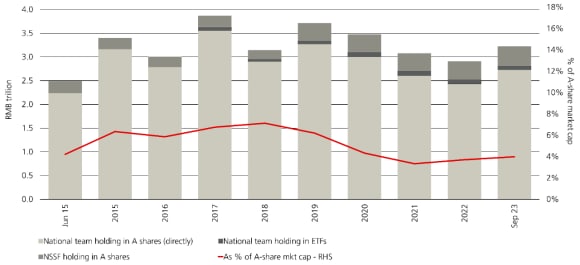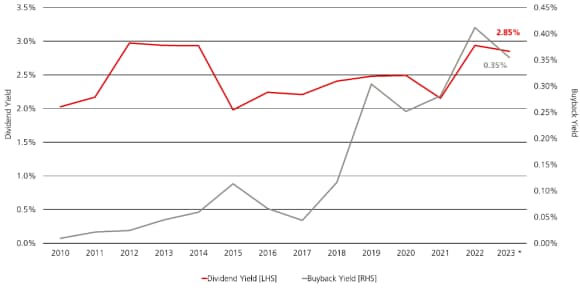Mirror image: Will this year prove to be the opposite of 2023 for China equities?
Reflections on the many reasons behind our more buoyant outlook on Chinese stocks this year

Thinking back to the first quarter of last year, sentiment for China investing post pandemic was remarkably positive. The upbeat mood unfortunately did not last and stocks mostly fell after spring, leaving investors frustrated for the rest of last year and dispirited as we entered 2024.
Today, Chinese equities as measured by the CSI 300 are down about 40% from the peak reached three years ago, but they have been climbing since February. While a mere month’s data does not make an upward trend, we believe a recovery could be in the making. Any upside surprise could deliver a reversal, making 2024 a mirror image of last year. Several reasons make us more positive on Chinese equities compared to last year.
Policy and regulations
Policy and regulations
To start, the tone of China’s regulatory environment has changed. As though on a pendulum, Chinese regulations tend to swing from one side to another. Some of the rules and controls announced two, three years ago are being rolled back partly due to industry pushback and a slower economy. Still, the shift in direction can seem slow and will take time.
That said, it is easy for investors to focus too much on the damage done in the past, without realizing the regulatory atmosphere has relaxed. One example is a draft proposal of new restrictions for online games late last year, which brought about an oversized market reaction and then quickly set aside. This suggests to us that investor sentiment remains extremely pessimistic when the attitude of senior policymakers towards regulations has actually swung to the other side. A total of 322 games had been approved in the month and a half that followed the draft proposal announcement.
More broadly, the government is being more proactive with fiscal and monetary policy support. While there is limited appetite for a massive stimulus package, policy measures have been targeted and have intensified in recent months to include cuts to bank reserves requirements and interest rates, funding for unfinished property projects, and stock buying from state investment vehicles.
Government backed funds lend support to the market

The government is prioritizing growth, a fact made clear at the recent Two Sessions, a key political event to watch for economic targets and policy signals. Policymakers set the same GDP growth target of around 5% for this year, pledging to put the economy on a sustainable growth path by transforming the existing development model and at the same time ease the overhang of the property crisis and local indebtedness. Besides an off-budget issuance of special ultra-long term treasury bonds at CNY 1 trillion, proposed stimulus measures are fairly moderate and within expectations. Those calling for a large scale stimulus or bold policy shifts to lift the still-soft economy in the short term and fix structural imbalances in the long term could be disappointed.
Taking into account all that has been put forward, the market response to stimulus measures has been muted. And while the extra stimulus this year pales in comparison to measures in 2008 and 2015, scale does not appear to be the deciding factor here. Looking below the surface, the current predicament is a confidence issue.
Chinese people have built and accumulated a great deal of wealth over the last 30, 40 years, and without downplaying the property market related wealth destruction in the last three years, there is still plenty of household wealth. Domestic tourism can serve as a quick reference point: Travel activities have been growing 5-7% every year since 2018 and reached 120% of the 2019 level this Chinese New Year (source: Ministry of Culture and Tourism, Wind, UBS estimates).
Wealth is not translating into spending on big-ticket items or long-term investments because a lack of confidence has arguably become sticky in the general public as well as in some entrepreneurs. Entrepreneurs are in a wait-and-see mode, not investing dynamically to capture future opportunities. Although policymakers pledge support, more needs to be put in action to rebuild consumer and business confidence. Once confidence returns, stimulus measures would have a much stronger impact than now.
In a sense, global investors feel the same way as Chinese consumers and entrepreneurs. International money is leaving the stock market, leaving China allocations at their lowest levels in years. Foreign direct investment (FDI) is trending downward, having turned negative briefly last year and back in positive territory on a net basis. We are less concerned about the outgoing capital itself since the Chinese banking system is well developed and has ample liquidity. However, the benefits from FDI go beyond money. Chinese companies have gained valuable lessons from working with foreign companies, and diminished exchanges are a setback that should be reversed.
Companies evolve strategies
Companies evolve strategies
Chinese companies are often resilient and quick to adapt to uncertain growth environments with new strategies. Many are now looking abroad for new growth opportunities, competing with well-established global brands in international markets with success. Others look within to control costs and make operations more efficient and streamlined.
Put another way, slower economic growth does not mean lower stock returns. The lack of correlation can be somewhat perplexing but well-illustrated in the example of Chinese telecommunication services operators. Growth has long been below 10% for these companies, but overall returns have been good recently.
These companies are finding different ways to generate earnings growth and improve cash flow. Many effectively automate parts of their operations and cut costs, allowing them to return excess cash to shareholders in dividends and share buybacks. This helps boost stock prices, which tells us that the best managed companies will be able to adapt and thrive in a lower growth environment.
Chinese companies have increased returns to investors via dividends and buybacks

Best time to invest
Best time to invest
In the past, there has been too much excitement about investing in China and the overexuberance in valuations was sometimes hard to justify. Sentiment tends to get ahead of reality. But now the narrative swirling around markets has been the collapse of the China investment case, which seems excessively pessimistic and stands unsupported against the prism of globally competitive companies, attractive stock valuations and a large economy with strong growth potential.
Undoubtedly, generating alpha from Chinese equities has become more challenging, but plenty of investment opportunities still exist. Finding them requires in-depth fundamental research to identify the next leaders – those with a strong competitive moat.
We always focus on strong companies with a proven, differentiated business model and ample financial resources. These companies tend to be able to pull through tough periods and rebound stronger after. We value long-term sustainable growth over short-term growth spurt because the transient nature of the latter is usually reflected in inflated share prices. When excitement meets high expectations, valuations can reach lofty levels, which we have tried to avoid.
History tells us that the best time to invest is when expectations, along with valuations, are low. In our view, all it takes for the asset class to rebound is an upside surprise, and we could be seeing a mirror image of last year for Chinese equities.
Get in touch
Whether you have a question or a request, we will be happy to get in touch with you.

